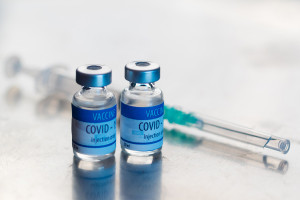NextUp: The Philly Company Making It Easier to Live With Migraine
There is no cure for migraine headaches, but Ctrl M Health has developed a digital platform to help migraine sufferers reduce the frequency and severity of their symptoms.

Ctrl M Health has developed a digital platform to help migraine sufferers reduce the frequency and severity of their symptoms. Photograph by JGI/Jamie Grill/Getty Image
“NextUp” is a weekly NextHealth PHL feature that highlights the local leaders, organizations and research shaping the Greater Philadelphia region’s life sciences ecosystem. Email qmuse@phillymag.com with pitches for NextUp.
Who: William Gadsden wanted to know why migraine — a chronic neurological disease that affects 39 million people in the United States alone — has historically gotten so little attention in the medical community.
“Migraine has always sort of lived in the shadows,” Gadsden said, noting that there is currently no cure for migraine and until recently, there were few places in the U.S. that offered specialized services to help people living with migraine to manage their symptoms. While it is often characterized as a simple headache, migraine has some debilitating symptoms, including nausea, vomiting, dizziness, extreme sensitivity to sound, light, touch and smell, and even tingling or numbness in the extremities or face — all symptoms that Gadsden says are best treated with a combination of medicine, and more importantly, self-care.
“There’s a misunderstanding of what migraine means. It’s not just a headache,” he said. “If you have or have had migraine, you’re experiencing pain that frankly, those of us without migraine really can’t conceive of. It can cause disruption, not just for hours, but for days, before you recover from it. It has impacts across your family life, your work life, and more.”
According to Gadsden, self-care practices can lead to fewer and less severe migraine. Last year Gadsden’s team partnered with the Jefferson Headache Center to incorporate the Center’s clinical expertise and medical protocols into an integrative digital health platform for migraine sufferers. From this collaboration, Ctrl M Health was born with Gadsden at the helm as its co-founder and chief executive officer. The company officially launched in September 2020 with headquarters in the Curtis Center in Center City.
What: Ctrl M Health is a digital health company focused on providing digital and mobile access to health and wellness solutions for people living with headache and migraine. The company’s lead product is a comprehensive digital platform designed to keep migraine sufferers informed and connected to care using three key components: a website with an extensive knowledge portal filled with articles on topics related to migraine, which are reviewed and overseen by Jefferson Health headache specialists; a mobile app with a subscription service that provides interactive programming, healthy activities and evidence-based strategies that people living with migraine can engage in daily; and an eCommerce store that offers a proprietary line of supplements to be used as non-pharmaceutical strategies for migraine management.

Ctrl M Health’s digital platform includes an app that is designed to keep migraine sufferers informed and connected to care. / Courtesy
“The goal is to empower those living with migraine with the knowledge, resources, and tools to proactively engage in self-care,” Gadsden said. “That means providing people living with a chronic disease for which there really is an absence of strong solutions, with the resources to engage in evidence-based activities that have been shown to be impactful for improving quality of life for people living with migraine.”
When: Since 2019, Ctrl M Health has raised $4.1 million to support the development and distribution of its digital platform. In August 2020, Ctrl M Health’s app became available through the Apple store. An Android version of the app is expected to be available by December 2020.
What it means: According to Gadsden, not everyone has access to the kinds of evidence-based resources Ctrl M Health provides. As of 2019, there were only 500 certified headache specialists available in the U.S. to treat 39 million migraine sufferers.
“The vast majority of people living with migraine, if they’re being treated at all, are being treated by their primary care physician who typically has one to one and half hours of training in medical school on migraine, which is a very nuanced chronic disease,” he said. “So, if you have migraine, you spend a lot of time searching in vain or in frustration for solutions. We’re trying to close that gap.”
Why it matters now: For Ctrl M Health, launching a business during a pandemic was challenging enough. But, according to Gadsden, the COVID-19 pandemic has created a period of increased social isolation and increased challenges to patients seeing their medical providers in person, which has led to a rapid acceleration in the adoption of telemedicine.
Telemedicine has proven to be an effective way for people to engage with healthcare providers remotely, but it still has its limitations. As Gadsden, explained, telemedicine is limited in that it doesn’t enhance the usual engagement a person would have with their provider, it just allows them to engage remotely.
“Our services really try to fill the gap between when you see your provider,” Gadsden explained. “We’re trying to engage with our consumers on a day-to-day basis, in a period where people can’t go to their doctor, or when they may not be able to get to a headache specialist or a primary care physician so we can augment that physician’s care by providing a resource that they can access wherever they are and allow them to engage on a day-to-day basis, in a supportive manner, with healthy activities focused on migraine.”
Gadsden estimates that roughly half of Jefferson Health’s Headache Center patient population has reported exacerbated symptoms of migraine due to the pandemic, including increased stress, increased sense of isolation, and increased disruption in their lives, which can be a trigger for migraine. For the other half, however, Gadsden says social distancing at home has had an unexpected positive effect; one that his company hopes to continue and build upon.
“We’ve actually found that some people have reported improvements to their migraine as a result of being home more due to the pandemic because they have been able to engage more consistently and with more deliberate action in wellness,” he said. “That’s exactly what we want to position our product to help with.”


